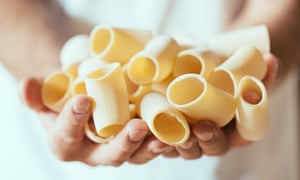The truth about pasta: 10 pasta myths busted | Barilla pasta and culture
Myth 1: Pasta makes you fat
Are you scrimping on the spaghetti to shed pounds? A recent study found that eating pasta is actually linked with a decreased likelihood of obesity and being overweight. Consumed as part of a Mediterranean-style diet, pasta was found to be associated with a healthy BMI, lower waist circumference and better hip-to-waist ratio. Try your own Mediterranean-inspired pasta dish by tossing a single portion of dried pasta â€" around 60g â€" with vegetables, olive oil, tomatoes, herbs, legumes or fish, for a 250-calorie meal.
Myth 2: Pasta has low nutritional value
You want fibre? Look no further. Scoffing a portion of wholewheat pasta will give you the same fibre boost as three times the weight in steamed broccoli â€" reducing your risk of heart disease, first-time stroke, type 2 diabetes and bowel cancer. Pasta has a low glycaemic index, which means the body breaks it down more slowly than other refined grains, such as those found in white bread, and it provides steady energy. It also partners perfectly with vegetables, beans, lean proteins, olive oil and herbs â€" exactly the kinds of nutrient-rich foods you should choose more often.
Myth 3: Fresh pasta is best
Reassuringly expensive and readily available in high-end delis and restaurants, fresh pasta is fashionable â€" and delicious â€" but some recipes are better suited to dry pasta, with its denser, firmer texture. Heavy, hearty and meaty sauces are best paired with dry pasta, which is also ideal for soups and casseroles, while fresh pasta calls for delicate sauces and gentle cooking.
Myth 4: Different colour means different taste
Spinach, beetroot, carrots, tomatoes and pumpkin are just some of the ingredients that can be used to colour pasta. However, the quantities used â€" and the typical addition of a flavoursome sauce â€" mean the pasta’s taste is not noticeably changed. The exception to this is black squid-ink pasta, with its subtly salty taste.

Myth 5: Any sauce, any pasta, anything goes
Generations of students have survived on anything with spaghetti, but careful pairing of sauce and shape yields the tastiest results. As a guide, larger or flatter pasta shapes suit thick, meaty or rich sauces, while long, thin shapes should be married with seafood, cream- or oil-based sauces. Short shapes go well with cheese or vegetable sauces and tiny pasta is for soups.
Myth 6: Salting the water means quicker cooking
Adding salt to the cooking water has a negligible effect on how long it will take to get dinner on the table; but it does make a difference to the taste. Adding salt as the water comes to the boil gives extra flavour. Barilla pasta head chef Luca Ciano suggests about 7g of salt added to one litre of water for every 100g of pasta. If that sounds a lot, just remember that most of it will be drained off.
Myth 7: Thorough draining is essential
No one wants gloopy pasta, and draining is important, but a little starchy cooking water can take a sauce to new heights, improving flavour, consistency and the ability to coat the pasta in sauce. Save a cup-full before draining. Long pasta, such as spaghetti and linguine, can be transferred to a pot of sauce with tongs, bringing a little of the precious cooking water with it.
Myth 8: Pasta contains egg
Most dry pasta contains no egg, despite its yellow tone. The ingredients are simple â€" just flour and water. The quality of the wheat is key though; the best pasta is made using only durum wheat, which gives it that famous al dente texture and its colour. Pastas made with egg are also available, and are particularly good with slow-cooked meat sauces.
Myth 9: Spoons are spaghetti’s best friend
While twisting spaghetti on a spoon may be a common method for getting slippery pasta from plate to mouth, it’s certainly not authentic. An Italian would only offer a spoon if the pasta were in a soup. A bit of practice should make slurp-free, fork-only twirling quite doable; the odd wayward strand is fine â€" it indicates the pasta isn’t overcooked.
Myth 10: Spaghetti grows on trees
Ok, so you don’t believe this one, but plenty did on 1 April 1957, when the BBC’s Panorama programme carried a report on the annual spaghetti harvest on the Swiss-Italian borders. Distinguished narrator Richard Dimbleby explained how the strands are plucked from the trees before drying in the sun. Some viewers contacted the programme, asking where they could obtain a spaghetti tree.

0 Response to "The truth about pasta: 10 pasta myths busted | Barilla pasta and culture"
Posting Komentar